Menu
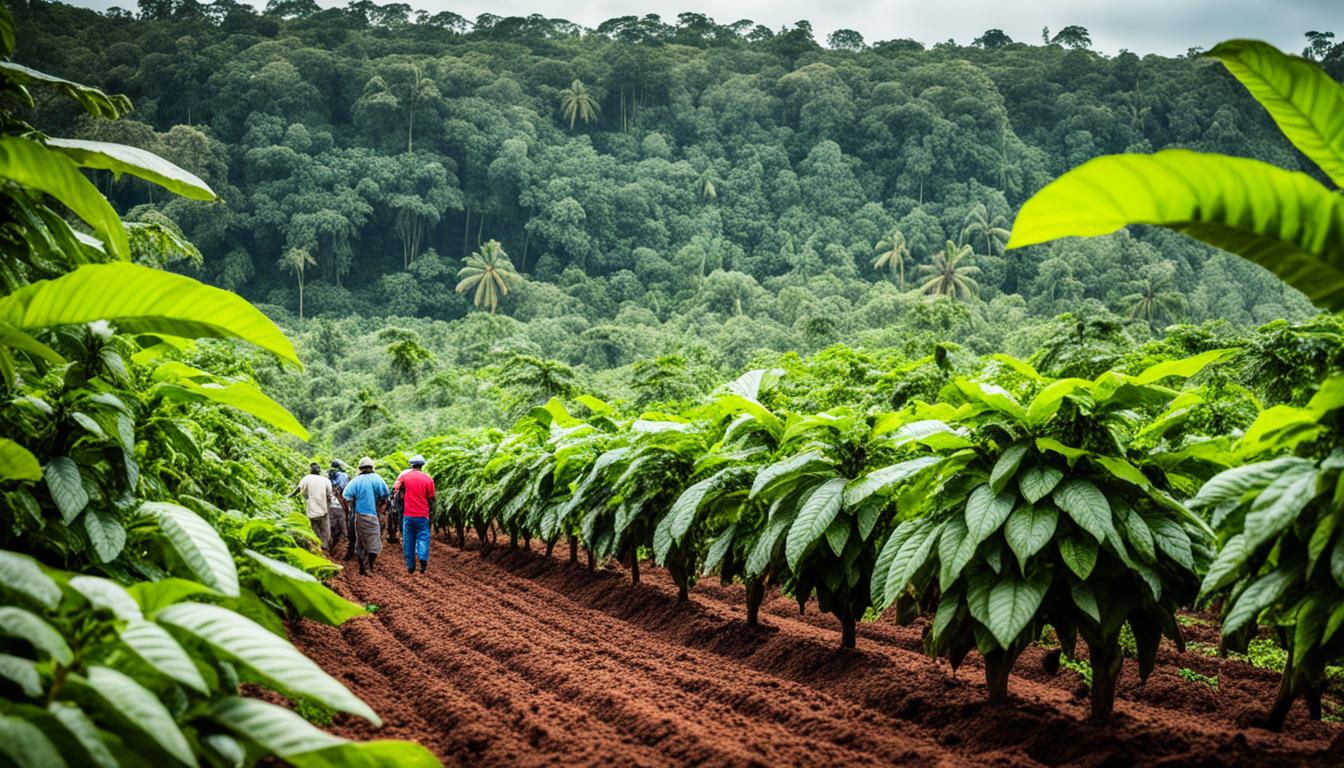
Do you know Ghana makes about 21% of the world’s cocoa, ranking it second globally? This shows how important cocoa is to Ghana. It helps over 6.3 million Ghanaians, making up about a quarter of their population. Cocoa is also Ghana’s second biggest export, contributing 7.3% to its economy since 1992. But, the industry faces big issues like land damage, deforestation, bad weather, and unfair treatment of farmers.
One way to deal with these problems is by focusing on sustainability. By farming cocoa in an eco-friendly and fair way, Ghana can protect its farmers and land. International groups and projects like Cargill’s Cocoa Promise are working towards this goal. They support ethical cocoa growing methods that also look after the environment.
Cocoa farming in Ghana is key in the world’s cocoa supply, with Ghana being the second largest producer. About 2 million small farmers take part. This involvement impacts not just their lives but also around 6.3 million others, making up 26% of the country’s population.
Cocoa is hugely important to Ghana’s economy. It’s the second most valuable export after gold. Cocoa makes up 7.3% of the country’s GDP. Control over cocoa exports is in the hands of the Ghana Cocoa Board. This ensures quality and a steady supply.
This control is important. The cocoa market in Ghana has seen 25 private licensed companies since being partly freed in 1993. Cocoa has helped reduce poverty in rural areas of the South even with the challenges farmers face. These include bad weather, land use fights, and low yields due to tired soil.
Using sustainable farming methods is crucial in Ghana’s cocoa industry. These methods help fight deforestation, protect wildlife, and keep the soil fertile. Such efforts prevent drops in the cocoa harvest over time.
The Cocoa Life project and Ghana Cocoa Board are working hard for sustainability. They’ve planted 1.3 million trees and set up CREMAs to help manage resources. These actions are steps in the right direction for a greener, more sustainable cocoa industry in Ghana.
139 organisations and 36 projects are working towards better cocoa sourcing and farming. They focus on building up skills, helping farmer groups, fixing cocoa farms, and getting climate-friendly certifications. Their work is important for saving the cocoa industry and the environment for future generations.
Sustainable farming is changing the game for small cocoa farmers. It’s helping them make more money and improve their lives. Their communities are also seeing better days because of it.
Better methods mean more cocoa and stable prices for the farmers. They now have ways to earn more and make their budgets more predictable. This is a big step in fighting the up-and-down money worries.
Getting a Fairtrade label really boosts their income. It lets them sell their cocoa for better prices in special markets. Fairtrade also means they work together in groups. This helps everyone get good deals and keep their prices steady.
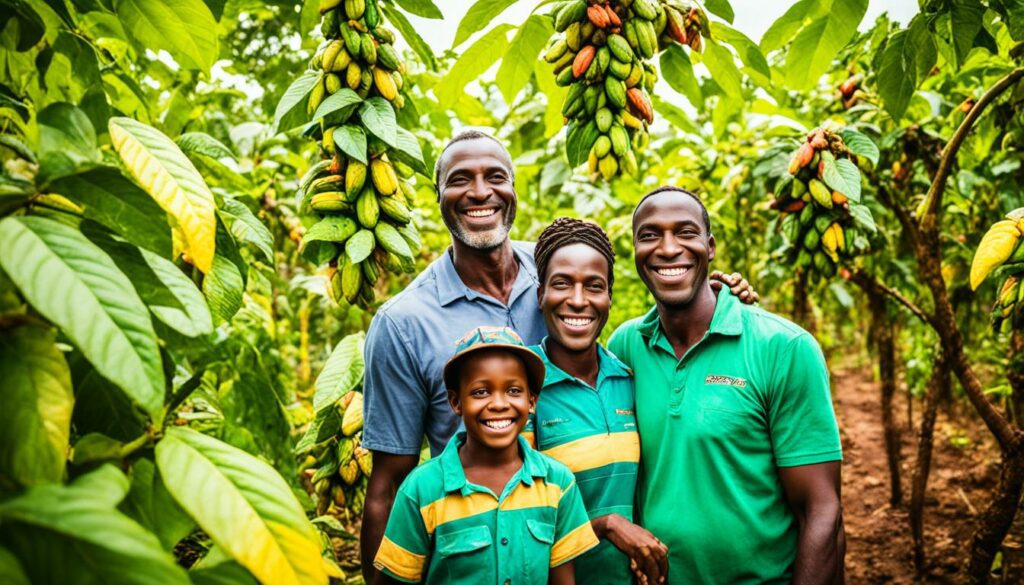
This way of farming isn’t just about money. It’s making social changes. With more cash, farmers can improve their own areas. They can build schools and health centres, making life better for everyone.
Also, it’s fighting bad work conditions and child labour. Respecting workers and paying them fairly is now essential. It’s making the whole process of growing cocoa more fair.
“Sustainable farming makes cocoa farming more fair and stable, changing lives for better in many ways.”
But, there’s more. This method helps the planet and the people who work the land. Areas like Côte d’Ivoire are losing too many forests. By farming in a sustainable way, farmers can protect the forests. This is good for nature and for the cocoa farmers’ future.
| Aspects | Traditional Farming | Sustainable Farming |
|---|---|---|
| Yield Stability | Variable | Increased |
| Income | Unstable | Stabilised through Fairtrade |
| Community Projects | Limited Investment | Improved through Higher Income |
| Child Labour | High | Reduced |
| Environmental Impact | High Deforestation | Preservation of Forests |
Ghanaian cocoa farmers face many challenges that hurt their productivity and the earth. These include problems with the environment, the economy, and access to good education.
Land becoming less fertile and trees being cut down are big problems in cocoa farming. This makes cocoa farms weaker and hurts many different plants and animals. Companies in places like Europe and North America often do things that make these issues worse. The Ghana Cocoa Board is trying to help by giving work to around 40,000 people to take care of sick or old cocoa trees. But, there are still too many trees being cut down and the land is not being managed well.
The changing climate is hitting cocoa farming hard. Weather that’s hard to predict, bugs and diseases, and less water are making farming cocoa even harder. The changing weather also makes how much cocoa is grown and its quality vary. This is bad news for the 865,000 or so small-scale cocoa farmers in Ghana. Bad weather not only messes up their farming plans but also means there’s a bigger chance of crops failing. This makes life very uncertain for people in the countryside.
Not knowing enough about good farming practices is another problem for cocoa farmers. There’s proof that learning about better ways to farm and improving society are both really important. But, not enough farmers know these things because they haven’t had good learning opportunities. There are some groups trying to help, like the Cocoa Abrabopa project and the Kuapa Kokoo cooperative. They are teaching farmers better farming ways and giving them certificates. Yet, there’s still a big gap. Many farmers can’t get loans, or the things they need to farm well, without more education.
| Challenge | Impact | Possible Solutions |
|---|---|---|
| Land Degradation and Deforestation | Reduced productivity and biodiversity | Rehabilitation programs, sustainable practices |
| Climate Change and Variable Rainfall | Yield fluctuations, quality loss | Climate-resilient crops, water management |
| Education and Knowledge Transfer Issues | Poor adoption of sustainable techniques | Training programs, cooperative support |
The sustainable livelihood framework is key for making cocoa farming communities stronger. It ties in with human, social, natural, physical, and financial assets. Let’s see how these parts help cocoa farming to grow sustainably.
Human capital is all about the people involved in cocoa farming. This includes their health, education, and the skills they have. In Ghana, for example, two million smallholder farmers depend on this. They use their knowledge to improve their farming methods. Education and training also help them deal with challenges, such as changing climates.
Social capital looks at how unity among farmers benefits everyone. In Ghana, about 26% of people find other ways to work within cocoa farming communities. Working together, they do other jobs like making palm oil or growing mushrooms. This boosts the whole community’s economy.
Natural capital concerns how well the land, water, and wildlife are used and protected. Ghana is a big player in cocoa, making about 21% of the world’s cocoa. But it faces problems like soil damage and illegal mining. Strategies, like planting trees with crops, not only protect the land but also bring in more money through new crops.
Physical capital is the necessary things like roads and tools. In cocoa farming, this helps get the cocoa from farm to market. The Ghana Cocoa Board supports this, making sure farms can work well and reach buyers. This is very important for the cocoa business to do well.
Without money, a good cocoa farming life isn’t possible. Cocoa is a big part of Ghana’s money-making, adding up to 7.3% of the country’s GDP. But the money isn’t steady, being best at harvest time. So, farmers also do things like keeping bees to have income all year. This way, they can manage well.
All these parts work together to help cocoa farmers stay strong despite problems. With the right approach, cocoa farming in Ghana can be sustainable and successful.
| Capital Type | Description | Examples |
|---|---|---|
| Human | Health, education, skills, and knowledge | Training programs, healthcare access |
| Social | Community networks and relationships | Community groups, local expertise |
| Natural | Land, water, biodiversity management | Agroforestry, alternative crops |
| Physical | Infrastructure and technological resources | Transportation, equipment, technology |
| Financial | Access to financial services and resources | Credit, savings, alternative incomes |
Fair Trade initiatives are key to ensuring cocoa farming is both sustainable and ethical. They help by offering better prices and focusing on social responsibilities. Both these aspects greatly improve the lives of cocoa farmers and their families.
Fair Trade cocoa ensures farmers get steady, fair prices. It also requires strict standards on tracing the origin of products. Tools like Fairtrace help keep track of each cocoa sale.
This transparency means farmers get receipts showing how much they’re paid for their cocoa. This makes the process fair and clear for everyone involved.
Efforts towards sustainability have boosted farmers’ income. For example, with a US$400 million investment, Mondelēz and Cadbury helped 200,000 farmers increase their yield by 20%. Fair Trade also provides a stable price for farmers, even when global prices drop. This steady price is usually around 70% of the world market value, protecting small farmers.
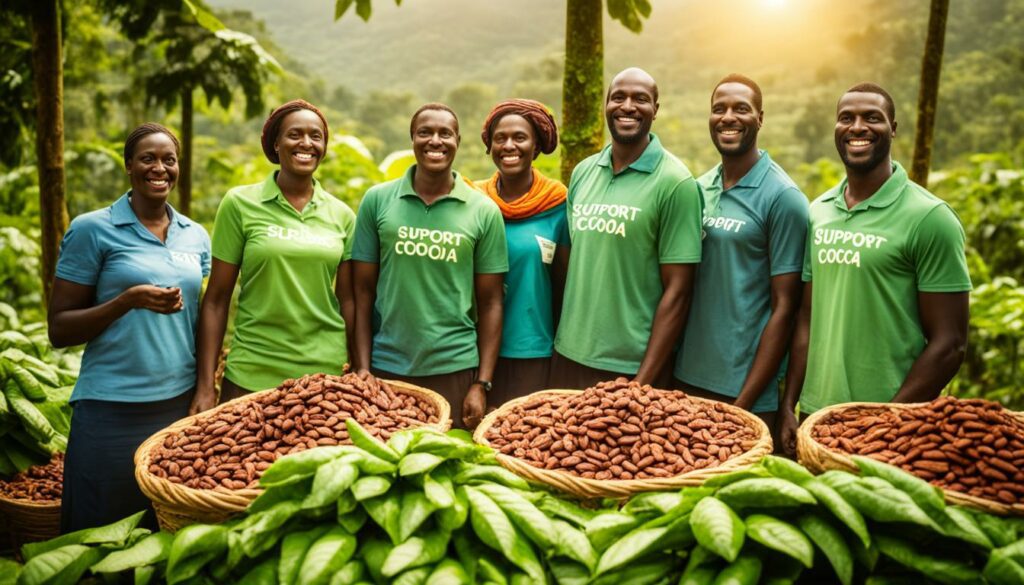
Fair Trade isn’t just about money. It also ensures cocoa is sourced ethically. The Cocoa & Forests Initiative aims to make all cocoa supplies traceable by 2025. This goal helps ensure cocoa farming meets high ethical standards, reducing issues like child labour and improving work conditions.
This isn’t just about the farmers. Fair Trade also requires collecting data on how farmers live and work, to drive changes. The gathered information helps decide where help is most needed, such as educational projects. Within three years, these cooperatives must have detailed data, so progress is always being made.
Companies like Cadbury, with initiatives worth £45 million, support more than just higher cocoa yields. They also aim to better the life of cocoa communities. This includes enhancing living conditions, raising household incomes, and improving access to education and healthcare. Scholarly work by experts like Professors Stephanie Barrientos and Amanda Berlan show how Fair Trade is key in the cocoa industry’s ethical transformation.
| Key Fair Trade Initiatives | Impact on Cocoa Farmers |
|---|---|
| Economic Stability | Stable pricing, predictable income |
| Traceability | Full tracking of cocoa lots, adherence to Fairtrade standards |
| Ethical Sourcing | Prevention of child labour, improved working conditions |
| Community Development | Increased household incomes, better access to education and healthcare |
Using new ideas is key for better cocoa farming that’s also good for the planet. These ways help save the environment, improve the amount and quality of cocoa beans.
Agroforestry mixes trees with cocoa plants to help nature. It stops clearing land too much and protects different plants and animals. This way, the soil stays healthy, less land washes away, and more carbon is stored.
Growing cocoa organically means not using harmful man-made chemicals. This keeps the land, water, and air safe for everyone. It also means the cocoa is better for you.
Cargill is big on these new farming methods. Since 2012, their Cargill Cocoa Promise has been a big part of looking after the future. They make most of their cocoa carefully to support good and fair ways of doing things. By 2030, they want to know exactly where all their cocoa comes from.
Technology has changed how cocoa is grown. GPS maps now track the cocoa journey clearly, helping check on farmers. For example, with CocoaWise™ BeanTracker, each cocoa bag is linked to the farmer that produced it. This way, there’s always proof that everything is done right.
Knowing exactly where cocoa comes from is very important. Cargill works with others like UTZ and Rainforest Alliance to make sure cocoa is grown and sold in the best way. They also check the cocoa to be sure it’s good for the people buying it.
The new tech is also great for teaching. In Ghana, children are learning better because of computers and the internet. 150 kids are already doing much better in their studies after just a few months. This shows that new farming methods can help communities grow in more ways than one.
| Company | Initiative | Outcome |
|---|---|---|
| Cargill | Cargill Cocoa Promise (2012) | Sustainable cocoa sector commitments |
| Cargill | CocoaWise™ BeanTracker | First mile traceability |
| Rainforest Alliance | Third-party Certifications | Enhanced ethical sourcing |
| Fairtrade International | Certification Programs | Improved cocoa farming practices |
| UTZ | Certification Standards | Boosted product quality and yield |
Organic cocoa production in Ghana has taken a big step forward. It is a crucial move for a sustainable cocoa future in Ghana. The country produces more than 800,000 metric tonnes of cocoa yearly. This makes up about 10% of its GDP and supports over 800,000 farmers, most of whom are smallholders. The shift to organic farming brings both eco-friendly benefits and helps the farmers improve their lives.
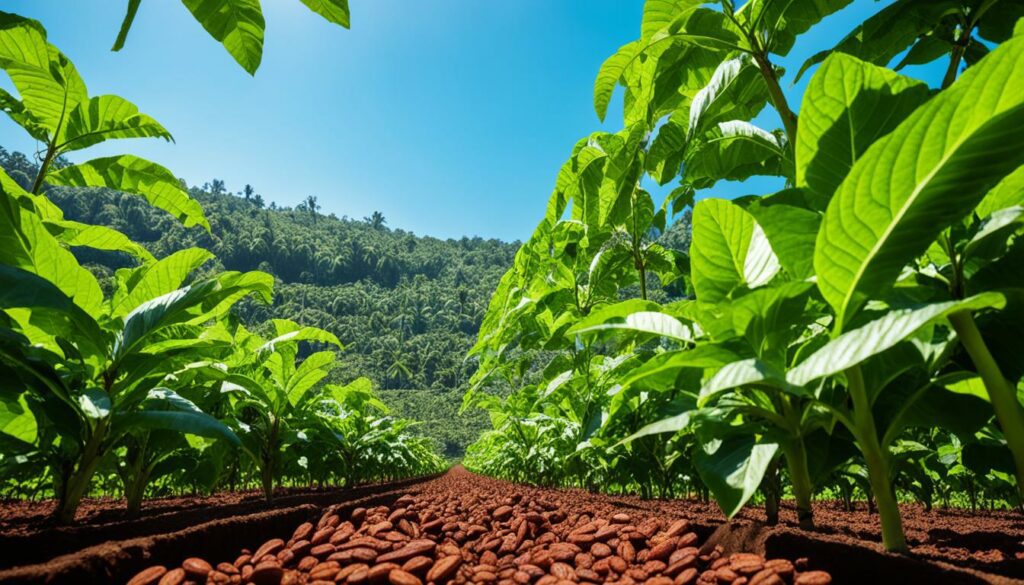
One big win from organic cocoa farming is its positive impact on the environment. Traditional methods have damaged natural forests in Ghana, Côte d’Ivoire, and Burkina Faso. These forests have shrunk by over 70% in the last 30 years. Going organic means better land care, more biodiversity, and no harmful chemicals. This is good for nature and for the farmers too.
Between 2016 and 2017, cocoa prices fell sharply from $3,000 to $1,900 per tonne. This hurt small farmers a lot. But, growing organic cocoa offers a way for them to be more financially secure. Also, Fairtrade and organic labels helped by paying around 180 million euros. This money was a big help, softening the blow of those low cocoa prices.
By focusing on organic methods, Ghana’s cocoa farmers can access better markets. Even with over 2 million children still working in cocoa fields in Ghana and the Ivory Coast, organic farming promotes fair and ethical practices. This leads to better conditions for cocoa farming communities, reducing child labour.
| Aspect | Statistic | Outcome |
|---|---|---|
| Annual Cocoa Production | 800,000 metric tonnes | 10% contribution to GDP |
| Impact of Price Decline (2016-2017) | From 3,000 to 1,900 USD | Severe losses for farmers |
| Fairtrade Premium in 2017 | 180 million euros | Support for farmers |
| Living Income (Côte d’Ivoire) | $2.51 per day | Aiming for economic resilience |
| Current Average Income | $0.78 per day | Poverty among farmers |
This cocoa case study supports wider efforts to protect the environment and human rights. The European Commission plans to stop products linked to deforestation from reaching EU markets. It also wants to make companies check their products don’t harm people or the planet. These steps are key to making organic cocoa farming a model for the future of the industry.
Transitioning to organic cocoa in Ghana has several big benefits. It helps nature, the economy, and the people. This case is proof that sustainable farming can make a positive difference. It supports the economy, cares for the environment, and builds a cocoa chain that is fair to all.
International cooperation is crucial for encouraging sustainable cocoa farming in Ghana. Organisations and nations must unite to tackle various issues, from land damage to use of forced labour in the cocoa sector.
NGOs have made a big difference by aiding cocoa farmers in Ghana. They support with education, money, and push for better practices. The International Labour Organization states that many in forced labour are in agriculture. NGOs strive to stop this, ensuring fair work and protecting worker rights.
International groups have stepped in to help Ghana’s cocoa farming, too. For example, the European Commission passed a new law in 2021. It makes sure harmful products, like cocoa from deforestation, don’t reach the EU. This pushes for more responsible sourcing.
Developing sustainable policies is vital for Ghana’s cocoa economy. The government and international friends have set rules to back such farming. For instance, Ghana’s cocoa prices are fixed at 70% the global price. This secures a fair income for farmers even when prices swing.
Certification programmes, such as Fairtrade, offer higher prices, motivating farmers to go green. Fairtrade’s income in 2017 was about 180 million euros. However, this money isn’t enough to meet all cocoa farmers’ needs. It’s suggested that these funds go to more than just farming better. They should also help with going organic, better the countryside, and start replanting trees in deforested land.
| Key Statistics | Details |
|---|---|
| EU Deforestation Imports | 36 per cent of products associated with global deforestation |
| Forced Labour in Agriculture | One in ten of the 16 million worldwide |
| Cocoa Production in Ghana | Over 800,000 metric tons annually |
| Farm Gate Price in Ghana | 70 per cent of world cocoa price |
| Fairtrade Premiums (2017) | Approximately 180 million euros |
| European Commission Policies | Mandatory EU-wide due diligence legislation (2021) |
The Cocoa and Forests Initiative is a turning point for cocoa farming in Ghana. It’s a promise from key players to stop deforestation and look after forest conservation in cocoa farming. I’ve seen how it changes cocoa farming to be greener.
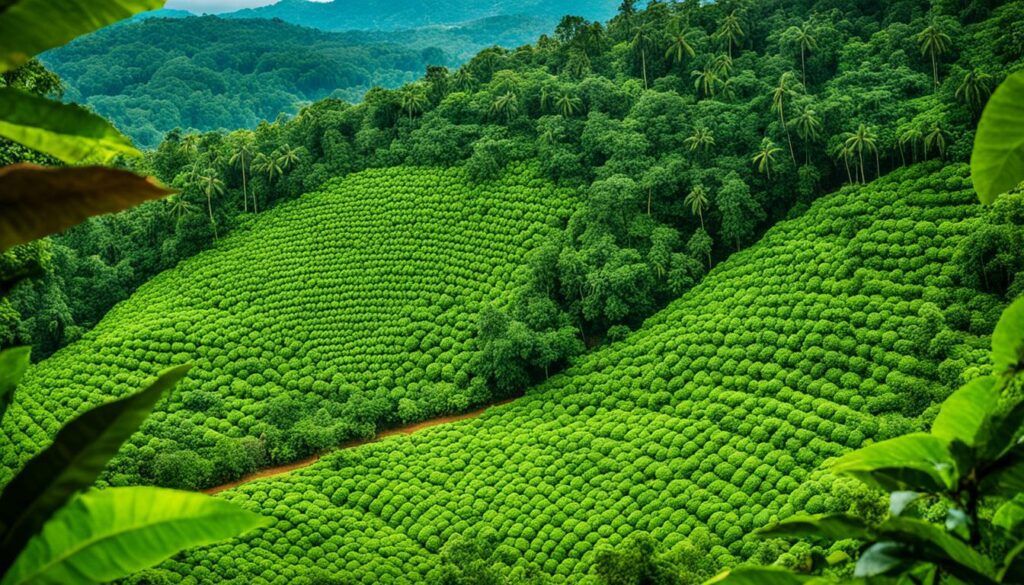
By 2021, Ghana earned $2.07 billion from cocoa sales. This makes up almost a quarter of its earnings from exports. It proves that doing cocoa farming in a way that keeps the land healthy is really important.
Many companies have found nearly 348,000 farms. They can now track where their cocoa comes from with 85% certainty. This means the cocoa you eat can help keep forests safe.
Since 2018, almost 4.7 million trees have been given out, reaching a total of 14.9 million. This was for planting in cocoa farms and other areas to keep the land green. It shows how much Ghana cares about this project.
“More than 321,000 farmers learned how to make their farms better, and 163,000 learned about ways to farm that help the climate. This shows Ghana is working to keep cocoa farming sustainable in many ways.” – Ghana Cocoa Industry Report
| Metric | Impact |
|---|---|
| Trees Planted (Green Ghana Project) | 40 million |
| Increased Producer Price | 63.5% from GHS 800 to GHS 1,308 per bag |
| Farms Mapped | 348,000 |
| Farmers Trained | 321,000 (Productivity), 163,000 (Climate-Smart Practices) |
| Global Cocoa Production Contribution | 25% |
A study in 2011 found that using zero shade for cocoa farming caused big forest loss. This made the land broken up and hurt the trees and animals. Then projects like Cocoa Life and planting 1.3 million trees have tried to fix this.
The Cocoa and Forests Initiative impact is not just good for the earth. It’s also helping 2 million farmers who work in cocoa. This plan is very important for Ghana, which is a huge cocoa maker in the world, providing a quarter of all cocoa.
The sustainable cocoa Ghana case study shows how important good farming practices are. It tells us about the good things these practices do for the economy, the environment, and people. By doing things in a better way, there are benefits for everyone.
Sustainable cocoa farming makes a big difference in Ghana’s economy. Ghana is a big player in the global cocoa market, providing a quarter of the world’s cocoa. Projects like the Cocoa Life from Mondelēz International are investing a lot, $400 million, to help 200,000 cocoa farmers. This helps make farmers’ lives better and keeps their income steady. Cocoa is so important to Ghana that it makes up 7.3% of the country’s GDP. It also supports about 6.3 million people working in the cocoa industry. Thanks to these efforts, productivity is up, and they’re fighting problems like soil loss from deforestation.
Using sustainable methods in cocoa farming helps nature. It focuses on taking care of the land and keeping plants and animals safe. One way is by planting 1.3 million trees to bring back shaded areas. This helps keep the forest whole and lets animals move around safely. It also means the soil is healthier and can store more carbon. These actions lead to fewer animals and plants dying out, and nature working better for everyone.
Sustainable cocoa farming helps people live better too. It offers chances for communities to work together, sends more kids to school, and makes healthcare better. The community now has a say in taking care of their land, which keeps it nice for future generations. It also makes sure that farmers can rightfully own the trees they plant. This gives them strength and hope for the future. Overall, these changes create stronger and happier communities. They also help Ghana as a whole move forward, all thanks to sustainable farming.
Ensuring supply chain traceability is key for cocoa’s future. Today, we rely on high-tech solutions to make the cocoa supply chain more clear for everyone involved.
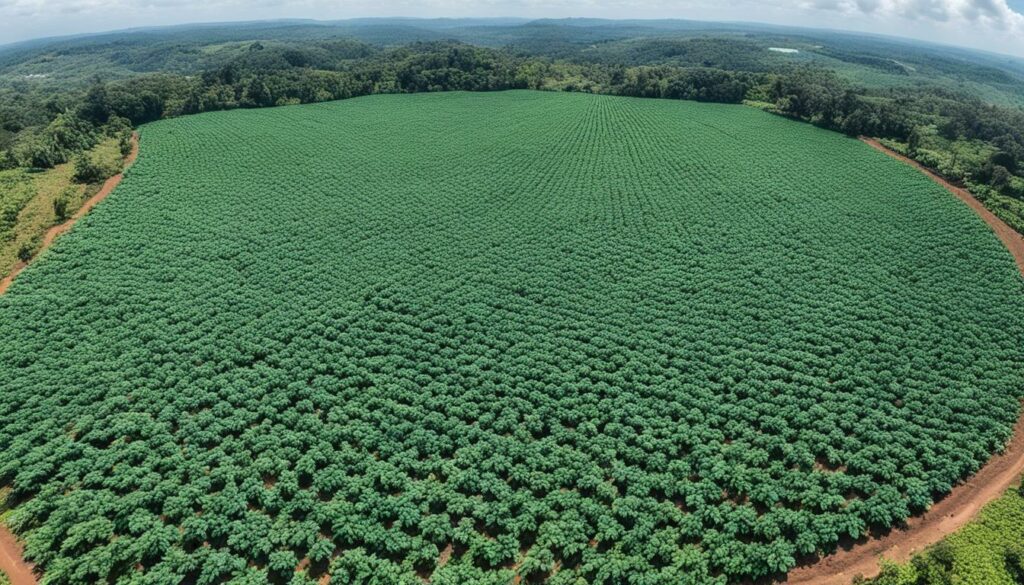
Technologies such as blockchain and instant verification systems transform how we follow cocoa sales. Seedtrace, for example, verifies each transaction three times. All key information is safely recorded on a public blockchain. This allows everyone in the supply chain to track deals live.
Koa, in Ghana, combines over 1,600 farmers using tech. It ensures these growers get paid fairly and that the whole process is clear, even where there’s no electricity or the internet. This helps small farmers overcome certain challenges. It gives them a trusted method for payments.
In addition, cocoa-producing nations like Côte d’Ivoire and Ghana have made national databases to track cocoa’s journey. This effort makes it easier to follow cocoa from the farm to the port. It helps meet important sustainability rules, like the EU’s about products not causing deforestation.
A strong team effort is behind these technological moves. The private businesses, NGOs, scientists, and governments all play a part. Groups like COCOBOD, Fairtrade, and Barry Callebaut show how joined-up efforts can improve cocoa transparency.
Being open about the supply chain offers more than just following rules. It lets us control risks better and run things smoother. With fresh, detailed data on cocoa farming, we can tackle problems faster.
Openness builds trust with both buyers and workers along the chain. When buyers know all about the farms and processes, they pick with more confidence. This trust supports the efforts to make cocoa sourcing sustainable.
Plus, putting everything out there means being ready to check and prove what you claim. Some companies now show exactly where the ingredients in their chocolate come from. They prove you can tell the full story and still do well in business.
Finally, by being clear and doing the right thing, we can stop unfair competition and dodgy practices. It’s good for the farmers and their communities. They can have a real say in how their land and resources are used.
Ghana plays a huge part in the world’s cocoa supply. It provides a quarter of the cocoa you enjoy. It’s second only to one other country in cocoa farming. Yet, this success has come with a big cost to the environment. Cocoa farming has been intense since the 1980s, leading to loss of forests.
Deforestation has harmed the soil, reducing cocoa production. Luckily, efforts like the Cocoa Life project and the UNDP’s work are helping. They’ve started planting 1.3 million trees to add shade back to the cocoa farms.
The future of cocoa farming looks bright. There’s a plan to invest $400 million by 2022 through the Cocoa Life project. This money aims to help 200,000 cocoa farmers and impact one million locals. It’s all about moving towards more sustainable farming methods.
There are also new local management methods being put in place. For example, the CREMA system in Ghana is helping 39 communities look after their lands better. This is an important step towards more sustainable cocoa farming.
Important attention is now being given to the lives of cocoa farmers and their families. It’s crucial that farmers are paid fairly and that child labor is stopped. Often, farmers get into debt due to high costs and little improvement in their yield. They need more financial help and information on how to farm sustainably.
There’s a worldwide push for cocoa to be sourced ethically and for farmers to get fair prices. Certification bodies like Fairtrade are there to help ensure farmers earn a fair price. But, more farmers need to benefit from these good practices. This means they need better access to finance.
To sum up, the future of cocoa farming in Ghana is being shaped by many things. These include technology, market needs, and new policies. Keeping an eye on where cocoa comes from and how it’s made will improve trust and encourage good farming practices.
| Aspect | Details |
|---|---|
| Global Contribution | 25% of global cocoa production |
| Environmental Issues | Forestation loss, soil nutrient depletion |
| Investment | $400 million by 2022 |
| Farmer Empowerment | 200,000 farmers targeted |
| Sustainability Initiatives | CREMA in 39 communities |
| Fair Trade Impact | Fair prices and premiums, need for wider access |
Sustainable cocoa farming in Ghana is vital for meeting social, economic, and environmental goals. Ghana is a key global player, providing about 21% of the world’s cocoa. This makes cocoa very important for about 6.3 million Ghanaians, or 26% of the population, who rely on it. Cocoa also boosts the economy, contributing 7.3% to GDP.
Cocoa is Ghana’s second-biggest export after gold, showing its great value. But cocoa faces big challenges like soil wear, diseases, and climate change. Many farmers also have low education, which makes it hard for them to use new farming methods. This situation calls for changes towards sustainable practices.
To save both the environment and the economy, sustainable cocoa farming is key. Methods like growing cocoa with trees and without harmful chemicals are proving to work well. The Cocoa and Forests Initiative and Fair Trade projects are steps in the right direction. Plus, with young people joining cocoa farming, the sector has a promising future.
The future of Ghana’s cocoa sector is critical. It must stay strong even with possible shifts to oil and more industrialisation. A mix of social, economic, and green efforts is needed to secure the future of cocoa farming in Ghana. This combined effort will keep cocoa as a main driver of the economy, ensuring a better environment and improving many lives in Ghana.
Cocoa farming is key to Ghana’s economy. It gives jobs to two million small farmers. Plus, it boosts the GDP a lot. This is because it’s Ghana’s second-biggest export.
Sustainable farming fights deforestation and protects the land. By doing so, it helps cocoa farming survive climate change. This makes sure cocoa farming can keep going for a long time.
Sustainable farming leads to better crops and steady prices. It also means farmers can earn from fair trade. This all helps farmers’ money situations, so they can do more with their farms.
These practices bring more money into local areas. This money is used for schools, health, and building projects. It uplifts the whole community.
The main problems are land getting worse, trees being cut down, and strange weather. Not knowing how to farm in a better way makes things hard too.
The Framework helps manage different parts of life needed for farming. This allows cocoa farmers to be strong against hard times. It leads to better cocoa farming that lasts.
Fair Trade helps by getting farmers better prices. It also stops child work and makes sure workplaces are good. This fits with what the world sees as right.
Using trees on farms and avoiding chemicals are new ways that work well. New tech for better crops and fighting diseases also helps.
Organic cocoa shows how to farm without hurting the planet. It gives farmers more money and helps them stick to their goals of being green.
Groups worldwide help with money and good farming methods. They also make rules that back up farming in the right way.
This Initiative stops forests from being cut down. It helps cocoa farming be safer for the environment.
The study found farmers earn more, nature is better, and communities do well. It shows doing cocoa farming better has many good results.
Traceability makes sure cocoa is farmed the right way. It helps buyers trust that the cocoa is made well. New tech is making this easier.
The future for cocoa farming in Ghana looks bright. Better tech, more demand for fair products, and solid laws are helping. This means cocoa farming is heading in a good direction.